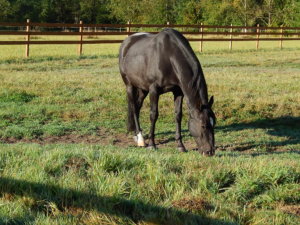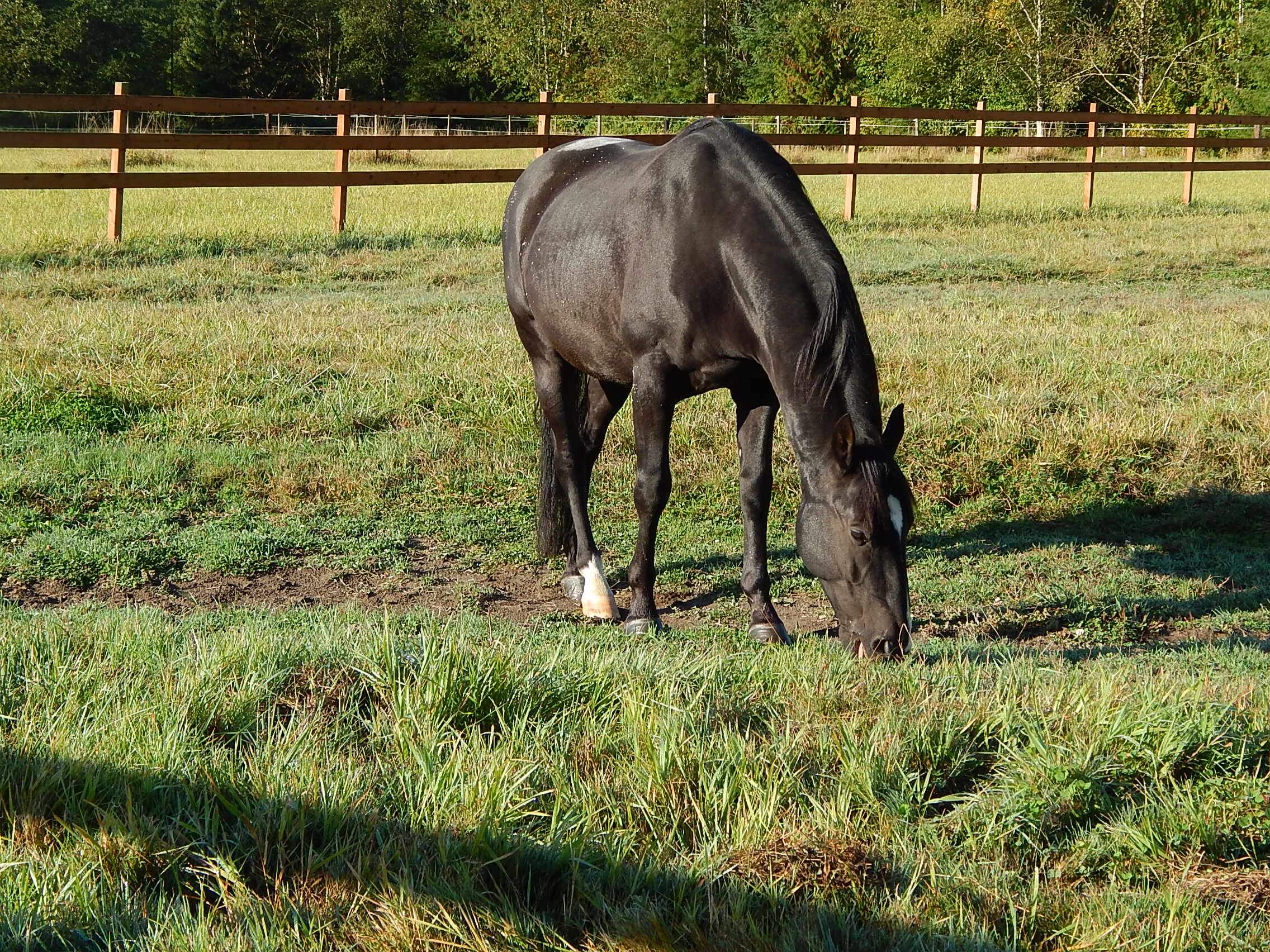Quality is What Counts
By Juliet M. Getty, Ph.D.

The quantity of protein in the diet is important but even more so is its quality. To achieve quality, we need to include additional protein sources to a forage-based diet. It all has to do with the way the body digests and utilizes protein.
Hay provides protein, but it’s poor quality
Hay’s protein is digested down to individual amino acids. This process starts in the stomach and is completed in the small intestine. These individual amino acids are absorbed into the blood stream and travel to tissues within your horse’s body to be reassembled into long, branched chains of amino acids to create proteins that are specific to your horse’s needs. There are hundreds of proteins in the body, some of which include those in the muscles, joints, skin, and hooves, as well as digestive enzymes, antibodies, and some hormones.
Grasses and grass hays should offer the foundation of your horse’s diet. But their protein content is of poor quality. That means that while they do offer amino acids, including essential amino acids (those which the horse’s body cannot produce or produce in sufficient quantity), they are inadequate in number and proportion. When amino acids from hay digestion reach a tissue, muscle for example, the muscle requires specific amino acids in the right number and proportion to build new muscle proteins.
Leftover amino acids cannot be saved for later
With a poor-quality protein, there will be many amino acids left over because some key amino acids are not available in sufficient quantity to produce muscle protein, as in our example. The leftover amino acids cannot be saved for later.
Instead, they go to the liver where they are broken apart––a process known as deamination. The amino acid is divided into two components: ammonia (which later gets converted to urea and excreted in the urine*), and an organic acid. The organic acid portion can undergo biochemical changes in one of three directions:
1. Converted to glucose
Most amino acids, once deaminated, can be converted to glucose. Glucose is the predominant blood sugar and is the necessary energy source for your horse’s nervous system, including his brain.
Once blood glucose rises, the pancreas responds by secreting insulin to get the glucose into many of the body’s tissues. This should raise a red flag for owners of insulin resistant horses, since it’s not just sugar and starch that raises blood glucose — excess amino acids can, as well. This will only occur, however, if the diet is low in carbohydrates.
Forages are generally high enough but if you are restricting forage to help your horse lose weight, he will need to get glucose from somewhere. He will likely lose muscle mass, since muscle offers a large amount of available amino acids, which can be deaminated and converted to glucose (through a process known as gluconeogenesis). In addition to muscle loss, he will utilize what protein he has in his diet to also offer glucose to keep his nervous system functioning.
2. Burned for energy
If your horse’s diet is low in calories he will use protein, as well as carbohydrates and fats, to meet his energy needs. Carbohydrates (sugars, starch, and digestible fibers) and fats are supposed to be used for energy. But protein is not; it’s supposed to be used for body protein synthesis. If your horse is not getting enough carbohydrates and fat in the diet, the dietary protein will be “wasted,” burned for energy, and not used for its intended function.
3. Converted to fat
Now isn’t that ironic? If you are feeding a low starch/low sugar hay to help your horse lose weight, and this is the only source of protein, that protein could actually be converted to body fat! This would only happen, of course, if the glucose and caloric needs have already been met. But feeding an appropriately low sugar/low starch hay, free-choice, without any additional source of protein, could make your horse get fatter.
The solution is not reducing forage. That would only cause the amino acids to be used for energy––for glucose (raises insulin) or encourage muscle loss. The solution is to provide enough quality protein so that the fourth and desirable outcome occurs: amino acids from hay digestion can be kept intact, not deaminated.
Add a different protein source
When amino acids are kept whole and not destroyed in the liver, they can be “strung” together in specific patterns to produce the protein needed within the body. The best way to ensure this is to add another protein source that has a different amino acid profile. That way, it can enhance the amino acid pool diversity. Hence, more amino acids are available for your horse’s health maintenance and repair.
An analogy would be making a beaded necklace where every fourth bead is red. You buy a bag of beads and there are some red ones, but you find that you cannot make a necklace the length you’d like because the bag doesn’t have enough red ones (like feeding poor-quality protein such as only hay). So, you go out and buy a different bag of beads with lots of red ones (another protein source). Now you have enough red ones to make a necklace, and maybe even more than one necklace.
The amino acid variety is far more important than the protein percentage
If your hay is high in protein, but it is the only source of protein, many amino acids will be destroyed. To reduce this, you’ll want to start by feeding a variety of grasses, not just one type of grass hay. Adding alfalfa will also help.
But a preferable approach is to offer a small amount of non-grass feedstuffs such as ground flaxseeds, chia seeds, hemp seeds, and other whole foods. This results in an assorted group of amino acids, sufficient to meet your horse’s needs.
Bottom line
To offer your horse the amino acid building blocks he needs to build and repair body proteins, it is important that the diet contain a variety of protein sources to maintain an adequate amino acid pool. If this pool is missing too many specific amino acids, many will ultimately be deaminated in the liver, rendering them unusable for body protein production.
Instead, they can be burned for energy, converted to glucose, and even stored as fat. Adding a small amount of protein-rich whole foods increases the number of intact amino acids, helping your horse remain strong and healthy.
* If your horse’s urine seems particularly strong-smelling, don’t assume that it is because he is getting too much protein. It could be because his protein intake is of poor quality, causing deamination of unused amino acids. Improving the protein quality will reduce urea content in the urine.
Juliet M. Getty, Ph.D. is an independent equine nutritionist with a wide U.S. and international following. Her research-based approach optimizes equine health by aligning physiology and instincts with correct feeding and nutrition practices. Dr. Getty’s goal is to empower the horseperson with the confidence and knowledge to provide the best nutrition for his or her horse.
Find a world of useful information for the horseperson at www.GettyEquineNutrition.com: Sign up for Dr. Getty’s informative, free e-newsletter, Forage for Thought; browse her library of reference articles; search her nutrition forum archives; and purchase recordings of her educational teleseminars and interviews.

Juliet M. Getty, Ph.D. is an independent equine nutritionist with a wide U.S. and international following. Her research-based approach optimizes equine health by aligning physiology and instincts with correct feeding and nutrition practices. Dr. Getty’s goal is to empower the horseperson with the confidence and knowledge to provide the best nutrition for his or her horse’s needs. Learn more at www.gettyequinenutrition.com.






